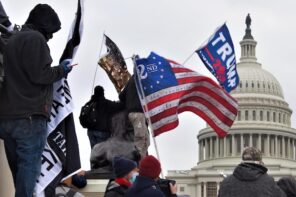The arrest of the Michigan-based Hutaree Militia has drawn worldwide attention, and in so doing surfaced one of the knottiest issues we face as a culture to which religious freedom and free speech are so central: How do we think about and describe religiously-motivated violence?
The Hutaree’s plans to murder a police officer and use IEDs to attack the funeral procession in order to catalyze an uprising against the federal government was shocking and made headlines around the world. Their action plan, while preposterous on its face, is not terribly surprising, and is in many respects a logical outgrowth of the eschatology of a wide swath of the Christian Right. But what has been most striking to me is the media’s high-profile use of the term “Christian militia.” This suggests to me that a tectonic shift may be underway in our underlying culture and politics as we continue to struggle with how to acknowledge the realities of actual and threatened religiously-motivated violence in the United States.
Until now, of course, the elephant in the room has been our double standard, at least since 9/11. We’ve had little difficulty acknowledging religious motivations when Muslims are involved, but it’s been rare to find the word “Christian” modifying terms like “militia” and “terrorism” in mainstream discourse.
Faith-Based Terrorism?
In 2003, I reported on the trial of convicted serial anti-abortion terrorist Clayton Waagner for Salon.com. Even the fiercely pro-life Attorney General John Ashcroft described him as a terrorist. Waagner had FedExed envelopes of white powder purporting to be anthrax to some 550 reproductive rights groups and clinics. In a manifesto published on the Web site of the anti-abortion Army of God, he declared himself to be “God’s warrior” and a “terrorist,” and threatened to kill as many abortion providers as he could.
Waagner’s threats arrived during the same period when real, post-9/11 anthrax attacks on media outlets and Congress killed five people. In some cases, whole city blocks were evacuated when Waagner’s pacakges were opened. People were stripped and hosed down with Clorox by hazmat teams in protective gear.
I quoted several people who agreed that the term “Christian terrorist” is practically taboo; even as the term “Islamic terrorist” was ubiquitous. The same double standard would have applied to militias. I don’t recall the term “Christian militia” ever being used, even if a group’s motives could be fairly described as religious.
Chip Berlet, senior analyst at Political Research Associates (a progressive think tank in Somerville, Massachusetts) agreed that the press stayed away from reporting the Waagner trial in droves. “Once somebody claims a religious motivation for an act of terrorism,” he said, “most people, including reporters and editors, become unglued.” If Waagner had been a self-identified Muslim terrorist instead of a Christian terrorist, Berlet observed, “he’d have been lynched by now.”
Ann Glazier, then the director of clinic security at Planned Parenthood Federation of America told me, “The notion of Christian terrorists is a place people don’t want to go. And the notion of there being more than one Christian terrorist is a place where people also don’t want to go.”
Reporters and editors often “fear to offend,” added Berlet. “But if it’s fair to say if we can see the religious motivations in the Taliban, we ought to be able to see them in Waagner or [Olympic Park and abortion clinic bomber] Eric Rudolph.” He notes that although Waagner and his associates in the Army of God “represent a tiny fraction of the wider Christian right, people don’t know how to make sense of it.” And reporters, he says, “walk away from it.”
Interestingly, an Army of God supporter named Chuck Spignola wrote a letter to the editor of Salon, agreeing with me. “In ‘The Quiet Fall of an American Terrorist,’ Frederick Clarkson rightly identified Clay Waagner, Eric Rudolph, and James Kopp as Christian terrorists.” Spignola went on to praise Christian terrorists as the cream rising to the top of churchgoing Christians.
A longer version of the letter was published on the Army of God Web site.
As recently as this past week, we saw the double standard in action. Scott Roeder (the man convicted of the murder of Dr. George Tiller, an abortion provider in Wichita, Kansas) was mostly described in the media as an anti-abortion extremist or anti-abortion militant, terms that fail to convey the depth and breadth of his views and the reasons for his crime.
At his sentencing Roeder said that in murdering Dr. Tiller, he believed he was acting to enforce “God’s Law.” Roeder, as part of his statement to the court, read from the posthumously published book by Rev. Paul Hill, a Christian Reconstructionist who viewed himself as a “Phineas Priest”—a kind of biblical vigilante assassin—who was executed for the murder of a Florida abortion provider and his security escort. Hill also believed in the need for militias and for a theocratic Christian revolution. But one would not know all that to read mainstream press accounts.
And while the sentencing was massively covered by national and international media, it would have been fair to describe Roeder as a “Christian terrorist,” though the media didn’t go there; he was described neither as a Christian nor as a terrorist in any of the news or broadcast accounts I could find.
In the ’90s, other terms were used to describe what we might now call Christian militias. The most famous militia group at the time, The Michigan Militia, had views similar to those of the Hutaree. It was founded and led by a Baptist minister named Norm Olsen and a deacon of his church, and they’d made an indoctrination video of its chaplain addressing new recruits explaining that abortion necessitated the founding of the militia. Nevertheless, it was typically described as “anti-government.” And while that was certainly fair, (as it would be to describe the Hutaree militia as anti-government), it also tended to obscure the indisputable religious motivations of this and many other militia groups large and small. Reporting on these groups at the time also tended to downplay their religious eschatology.
The shorthand descriptions of such groups and individuals sometimes depends on the context. Some fall under the category of “hate groups,” and their acts as “hate crimes.” While these terms can be useful, they too can obscure religious motivations. For example, the once-infamous Aryan Nations group referred to itself as the Church of Jesus Christ, Christian, and its leader was Rev. Richard Butler, a minister in one of the sects generally referred to as Christian Identity.
The uneven evolution of our thinking about these things, and the language we use to describe them, casts fresh light on how we use other shorthand terms in this complex and fraught dimension of public life. The term “faith-based,” for example, we use more or less synonymously with “religious” and as substitutes for such terms as “ecumenical” and “interfaith.” It has become a warm and fuzzy term used for glossing over religious differences, both for reasons of inclusiveness and to conceal exclusion. But we would never describe the Aryan Nations as a “faith-based” hate group or the Hutaree as a faith-based militia, or Clayton Waagner as a “faith-based terrorist.”
The rise of the term “faith-based” is probably closely related to our difficulty in ascribing religious motivations to hate and violence, unless of course it is the religion of foreigners with whom we are at odds or at war. Such characterizations can be taken as highly inflammatory. Terms like “Christian militia” or “Islamic terrorism” can suggest that terrorism and militias are more characteristic of these enormous and highly-varied religious traditions than is the case. And there are certainly those who do not hesitate to exploit such opportunities. At the same time, the current use of the term “Christian militia” suggests to me at once a certain inevitability (since the Hutaree feature their religious identity on their Web site) and a certain maturity in our collective ability to acknowledge the reality of the situation without hyperbole or inappropriate defensiveness with regard to the use of the term—Christianity—that fairly describes the majority of religious believers in the United States, for all of their extraordinary diversity.
That said, regarding diversity among Christians in the U.S., we have no central ecclesiastical authority to define who and what is and is not Christian. Lacking common definitions can affect our responses to the likes of Clayton Waagner, Scott Roeder, and the Hutaree. For example, liberal Washington Post columnist Eugene Robinson wrote regarding the Hutaree: “I put the word Christian in quotes because anyone who plots to assassinate law enforcement officers, as a federal indictment alleges members of the Hutaree militia did, is no follower of Christ.” Of course the Hutaree might say the same thing about Robinson. Scott Roeder certainly did not view Dr. Tiller as a Christian, even though he was serving as an usher at Sunday service at the Lutheran Church when he shot him in the face. [For further discussion see Gary Laderman’s What Do ‘The Christians’ Believe? Easter Reflections from a Non-Christian, and then Biblical Inerrancy: Responses to “What Do ‘The Christians’ Believe?”—ed.]
RD contributor Chip Berlet, correctly I believe, wrote that the ideas of the Hutaree are analogous to those of such Christian Right leaders as Tim LaHaye and Pat Robertson. But if we follow Robinson, shall we say that LaHaye and Robertson are not followers of Christ? Or do people stop being Christians only when they commit or are alleged to have planned to commit violent crimes? If so, having appointed ourselves as the arbiters of apostasy, we then cannot describe such people as Christian terrorists or Christian militias because by definition they have auto-excommunicated themselves.
Finally, what terms we use depends on the occasion. While the media term of choice for the Hutaree was “Christian militia,” federal prosecutors have carefully avoided religious references. Assistant US Attorney Ronald Waterstreet, who summarized the case in court, insisted that the charges “aren’t about a religion or the militia. It’s a group of like-minded people who decided to oppose the authority of the United States by using weapons and force.” Similarly in the indictment he described the Hutaree as “an anti-government extremist organization” whose members wear a patch on their uniform that includes a cross and the initials CCR. The indictment did not explain that the name Hutaree meant “Christian warrior” and that CCR stands for “Colonial Christian Republic.”
“The Hutaree’s enemies,” the indictment continues, “include state and local law enforcement authorities deemed to be ‘foot soldiers’ of… the new World Order.” Of course, ‘foot soldiers for the New world Order’ does not help anyone understand that the Christian warriors of the Hutaree saw themselves as fighting an end-times battle with the agents of the Antichrist. For their purposes, they may not need to. But even as the feds sought to elide references to religion, they certainly opened the door to draw on the full palette of possibilities in their vision of end times religious war, since the indictment also said that the Hutaree’s enemies list includes “anyone who does not share their beliefs.”




